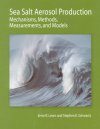![Sea Salt Aerosol Production Sea Salt Aerosol Production]()
Click to have a closer look
About this book
Contents
Customer reviews
Related titles
About this book
Sea salt aerosol (SSA) exerts a major influence over a broad reach of geophysics. It is important to the physics and chemistry of the marine atmosphere and to marine geochemistry and biogeochemistry generally. It affects visibility, remote sensing, atmospheric chemistry, and air quality. Sea salt aerosol particles interact with other atmospheric gaseous and aerosol constituents by acting as sinks for condensable gases and suppressing new particle formation, thus influencing the size distribution of these other aerosols and more broadly influencing the geochemical cycles of substances with which they interact. As the key aerosol constituent over much of Earth's surface at present, and all the more so in pre-industrial times, SSA is central to description of Earth's aerosol burden.
Contents
Preface ix
1. Introduction 1
1.1. Sea Salt Aerosol (SSA) and its Importance 1
1.2. Methods of Determining Size-Dependent SSA Production Fluxes 5
1.3. Scope of This Work 5
2. Fundamentals 9
2.1. Description of SSA Particle Sizes, Concentrations, and Fluxes 9
2.2. Major SSA Production Mechanisms 35
2.3. Factors Affecting SSA Production, Entrainment, Transport, and Removal 37
2.4. Structure of the Atmosphere Over the Ocean 44
2.5. Chemical and Physical Properties of Seawater and SSA Particles 47
2.6. Kinematics and Dynamics of SSA Particles 63
2.7. Mechanisms for Removal of SSA Particles From the Atmosphere 71
2.8. Transport of SSA in the Marine Boundary Layer 77
2.9. Vertical Distribution of SSA Particles 82
3. Methods of Determining Size-Dependent Sea Salt Aerosol Production Fluxes 101
3.1 Steady State Dry Deposition Method 101
3.2. Whitecap Method 105
3.3. Concentration Buildup Method 107
3.4. Bubble Method 109
3.5. Micrometeorological Methods 110
3.6. Along-Wind Flux Method 113
3.7. Direct Observation Method 11 6
3.8. Vertical Impaction Method 11 6
3.9. Statistical Wet Deposition Method 117
3.10. Summary of Methods for Flux Determination 117
4. Measurements and Models of Quantities Required to Evaluate Sea Salt Aerosol Production Fluxes 119
4.1. Sea Salt Aerosol Concentrations 120
4.2 Near Surface Field Measurements Pertinent to SSA Production 183
4.3. Laboratory Studies Pertinent to SSA Production 187
4.4. Bubbles in the Oceans 235
4.5. Oceanic Whitecaps 256
4.6. Dry Deposition 2 73
4.7. Minor SSA Production Mechanisms 289
5. Sea Salt Aerosol Production Fluxes: Estimates and Critical Analysis 299
5.1. General Considerations 299
5.2. Steady State Dry Deposition Method 303
5.3. Whitecap Method 314
5.4. Concentration Buildup Method 320
5.5. Bubble Method 322
5.6. Micrometeorological Methods 329
5.7. Along-Wind Flux Method 332
5.8. Direct Observation Method 337
5.9. Vertical Impaction Method 338
5.10. Statistical Wet Deposition Method 338
5.11. Comparison of Flux Estimates 339
6. Applications and Implications 345
6.1. The Climate Connection 345
6.2. Representation of SSA Production Flux in Chemical Transport Models 346
6.3. Status and Prospect 349
Principal Symbols 353
List of Figures 357
List of Tables 358
References 359
Index 409
Customer Reviews








































